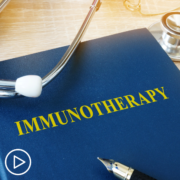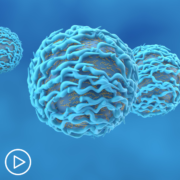What Are the Side Effects of Myeloma Immunotherapy?
What Are the Side Effects of Myeloma Immunotherapy? from Patient Empowerment Network on Vimeo.
Myeloma specialist and researcher Dr. Krina Patel discusses the common side effects of immunotherapy and reviews tools that may be used to prevent complications.
Dr. Krina Patel is an Associate Professor in the Department of Lymphoma/Myeloma at The University of Texas MD Anderson Cancer Center in Houston, Texas. Dr. Patel is involved in research and cares for patients with multiple myeloma. Learn more about Dr. Patel, here.
Related Resources:

|

|

|
Transcript:
Katherine:
Are there other side effects that patients should know about and side effects that they might experience?
Dr. Patel:
Yeah, so neurotoxicity is one that we don’t see as much as we see in lymphoma patients, which is again great but sometimes people can get something called ICANS, which is a type of neurotoxicity in the first 30 days after CAR T.
And basically, it can be as bad as seizures, but thankfully we don’t see that very often, or I haven’t seen it at all. But it can cause confusion. It can cause people to be extra sleepy. So, we have different treatments that we give to turn that around. Longer term, really, the big side effects are the counts being low. So, what we call cytopenias. So, white count, hemoglobin, platelets.
And so, that is something we see quite often in our patients who have had a lot of therapy for myeloma already, and then are getting something like CAR T.
So, a lot of my patients will still need transfusions even a month or two or three after, and we’re giving GCSF to help their white count come back up, et cetera.
Katherine:
What’s that?
Dr. Patel:
So, G-CSF is basically a growth factor that helps your neutrophil; so, a different type of white blood cell – come back up, which helps fight against bacterial infections.
So, it’s the same medicine for anyone who’s had a stem cell transplant. It’s the same medicine you get to get your stem cells into your blood but it’s at a lower dose. But again, it’s to avoid infections, to help present bacterial infections. The other one is infections can also be caused because of low IgG levels or what we call immunoglobulins; these are our antibodies that we have.
And the good news is, when CAR Ts or bispecifics or some of these immune therapies work really well, they’ll kill as many myeloma cells as we possibly can.
But they also kill good cells. So, they kill good plasma cells that make us antibodies and good B cells that make us antibodies. So, when that happens, people’s IgG levels will go down and that puts you at risk for infection too. So, we actually aggressively give people IVIG to help prevent those infections.



